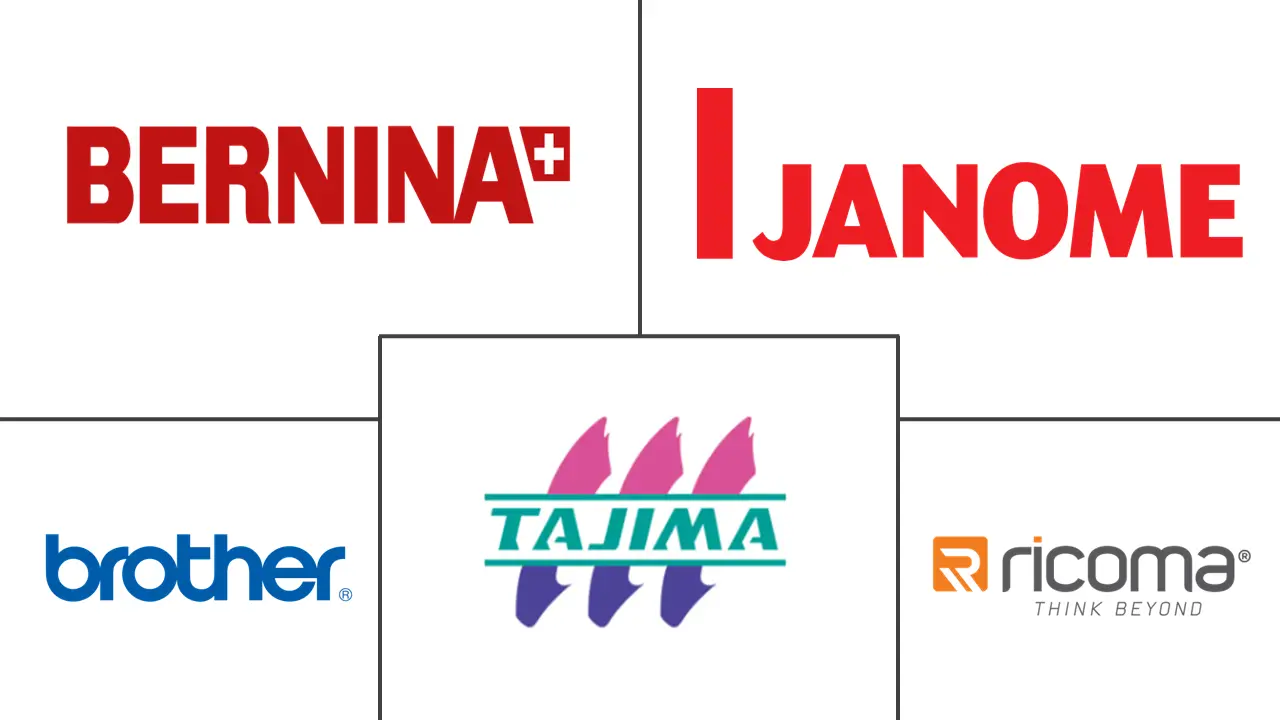Embroidery Machine Market Size and Share

Embroidery Machine Market Analysis by Mordor Intelligence
The Embroidery Machine Market size is estimated at USD 1.20 billion in 2025, and is expected to reach USD 1.60 billion by 2030, at a CAGR of 5.92% during the forecast period (2025-2030). A sizeable portion of this expansion stems from policy incentives such as the Indian Production Linked Incentive (PLI) scheme, which raised allocations for textiles from Rs 45 crore (USD 54.2 million) in 2024-25 to Rs 1,148 crore (USD 1.38 billion) in 2025-26. Parallel momentum comes from rapid technical-textile uptake in automotive, medical, and aerospace components, a sector projected to reach USD 346.67 billion by 2030. Fully automated, computerised machines gain prominence because IIoT-enabled efficiency analytics shorten pay-back periods in Chinese contract factories, while single-head units thrive on on-demand customisation among direct-to-consumer (DTC) brands. Regionally, Asia-Pacific commands the bulk of installations and still posts the world’s fastest growth, helped by China’s optimisation of contract manufacturing and Vietnam’s export-oriented investment. Competitive intensity increases as Chinese entrants rival established Japanese and German suppliers, yet barriers remain high for cash-constrained SMEs owing to multi-head line capex above USD 50,000.
Key Report Takeaways
- By product type, multi-head machines led with 68.7% revenue share in 2024; single-head machines are projected to expand at an 8.7% CAGR to 2030.
- By technology, fully automatic/computerised units captured 65.6% of the embroidery machine market size in 2024 and are growing at 8.2% through 2030.
- By application, apparel and garment equipment accounted for 63.4% share of the embroidery machine market size in 2024, while technical textiles advance at a 10.0% CAGR.
- By end-user, the industrial segment held 66.5% of the embroidery machine market share in 2024; home and personal use devices record the highest projected CAGR at 6.3% to 2030.
- By distribution channel, offline networks retained 70.5% revenue share in 2024; online sales rise at a 7.1% CAGR through 2030.
- By geography, Asia-Pacific commanded 63.5% of the embroidery machine market share in 2024, and the same region leads regional growth at 7.8% CAGR through 2030.
Global Embroidery Machine Market Trends and Insights
Drivers Impact Analysis
| Driver | (~) % Impact on CAGR Forecast | Geographic Relevance | Impact Timeline |
|---|---|---|---|
| Production-Linked Incentive schemes in India and Vietnam subsidise technical-textile lines | +1.5% | APAC core | Medium term (2-4 years) |
| Surge in on-demand custom apparel among North-American DTC brands | +1.2% | North America, EU spillover | Medium term (2-4 years) |
| IIoT-enabled OEE analytics in Chinese factories reduce pay-back periods | +0.9% | China-centric | Short term (≤ 2 years) |
| EU athleisure outsourcing to Eastern Europe elevates ultra-high-speed multi-head demand | +0.8% | EU, Eastern Europe | Long term (≥ 4 years) |
| Sustainability shift from screen printing to thread-based logos in EU corporatewear | +0.7% | EU, North America | Medium term (2-4 years) |
| Fashion-tech personalisation start-ups raise demand for software-compatible home machines | +0.6% | Global tech hubs | Short term (≤ 2 years) |
| NCAA merchandising boom lifts 10-needle machine demand in US collegiate segment | +0.4% | North America | Short term (≤ 2 years) |
| Source: Mordor Intelligence | |||
Production-Linked Incentive Schemes Transform Asian Manufacturing Dynamics
PLI allocations in India multiplied 25-fold between fiscal 2024-25 and 2025-26, positioning technical textile capacity as a strategic priority and guaranteeing baseline orders for high-speed embroidery lines [1]Ministry of Commerce & Industry, “PLI Scheme Allocation 2025-26,” commerce.gov.in. Vietnam’s parallel export push further boosts demand, as local factories install multi-head machines to satisfy stringent buyer specifications. The result is a structural decoupling of regional demand from conventional apparel cycles and a tighter linkage to policy milestones and compliance timelines.
North-American DTC Brands Drive Single-Head Customisation Demand
DTC labels prioritise short runs and rapid design refreshes to guard against inventory risk, fuelling robust sales of single-head units. These machines, once largely hobbyist, now include industrial-grade tension control and intuitive software that accelerate prototyping and micro-batch fulfilment. Collegiate sports merchandising intensifies this pattern because roster changes and event-driven releases require frequent artwork updates.
IIoT Integration Accelerates Pay-Back Optimisation in Contract Manufacturing
Embedding sensors and manufacturing-execution software raises utilisation rates and quality yields in Chinese plants, cutting the pay-back time for multi-head lines from three-plus years to fewer than 24 months. Equipment that offers native connectivity, therefore, enjoys placement preference, pushing manufacturers to bundle data interfaces as a standard feature rather than a premium add-on.
Sustainability Mandates Accelerate Thread-Based Logo Adoption
Corporate uniform suppliers across the EU switch from chemical screen prints to thread embroidery in response to circular-economy legislation and durability requirements[2]EURATEX, “EU Textile Industry Facts & Figures 2025,” euratex.eu . Thread decoration offers wash resistance and enables easier garment disassembly for fibre recovery, aligning with forthcoming eco-design directives and reinforcing steady demand for commercial-grade heads.
Restraints Impact Analysis
| Restraint | % Impact on CAGR Forecast | Geographic Relevance | Impact Timeline |
|---|---|---|---|
| Direct-to-garment digital printing cannibalises entry-level embroidery spend | -1.1% | Global, particularly developed markets | Medium term (2-4 years) |
| Grey-market control-boards & counterfeits in APAC erode OEM margins | -0.9% | APAC, China and Southeast Asia focus | Short term (≤ 2 years) |
| Cap-ex > USD 50k for multi-head lines deters SME decorators in South America | -0.8% | South America, SME-dominated markets | Long term (≥ 4 years) |
| EU talent gap—aging operator pool limits machine utilisation rates | -0.6% | EU, skilled manufacturing regions | Long term (≥ 4 years) |
| Long Learning Curve and Software Complexity Deterring New Entrants in Entry-Level Segment | -0.4% | Global, entry-level market segments | Medium term (2-4 years) |
| Source: Mordor Intelligence | |||
Digital Printing Competition Intensifies at Entry-Level Price Points
Lower set-up costs and faster turnaround attract small decorators to direct-to-garment (DTG) printers, compressing replacement demand for entry-level embroidery models. Rising print resolutions narrow the aesthetic gap, while sustainability messaging around reduced water use resonates with brands committed to environmental targets[3]Kornit Digital, “Sustainability in On-Demand Printing,” kornit.com .
Capital Expenditure Barriers Limit SME Market Penetration
SMEs in Latin America, representing more than 95% of all enterprises, often lack financing channels able to absorb multi-head investments, a challenge underscored by the OECD SME Policy Index[4]OECD, “SME Policy Index: Latin America and the Caribbean 2024,” oecd.org. The outcome is a two-tiered market in which large regional exporters modernise rapidly while small contractors defer upgrades.
Segment Analysis
By Product: Multi-Head Dominance Faces Single-Head Innovation Challenge
Multi-head equipment generated 68.7% of the embroidery machine market revenue in 2024, reflecting its unmatched efficiency for bulk orders. Yet single-head machines show an 8.7% CAGR through 2030 as personalisation and DTC adoption rise. The embroidery machine market size for single-head units is expected to expand from USD 0.38 billion in 2025 to USD 0.59 billion by 2030, underscoring meaningful catch-up potential. Modular platforms such as Tajima’s TMBP2-SC unify cap, flat, and bulky articles within one frame, demonstrating how manufacturers bridge diverse use-cases in a single chassis.
Parallel growth in chenille, sequin, and laser attachment modules supports premium craft effects in home décor and luxury accessories. This variety enlarges the addressable base for suppliers, though it also forces tighter inventory management across spare parts and technical support.
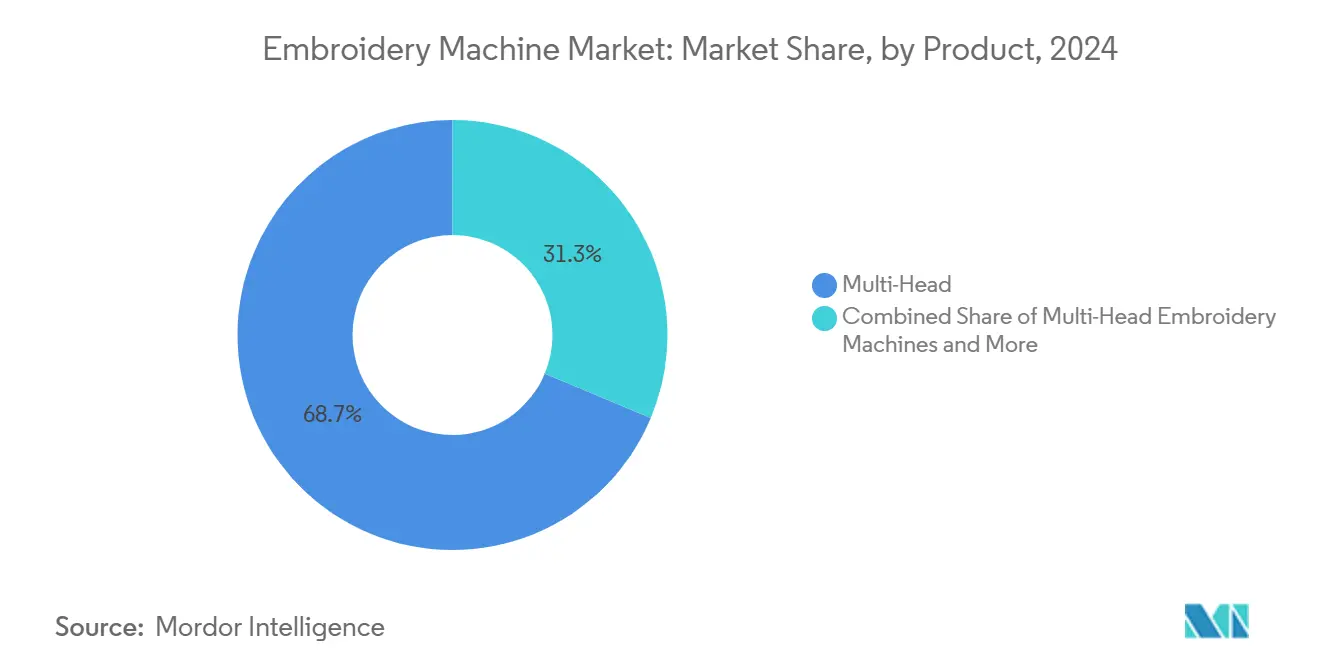
Note: Segment shares of all individual segments available upon report purchase
By Technology: Automation Drives Computerised Machine Adoption
Automated, computer-guided units accounted for 65.6% of the embroidery machine market revenue in 2024. Continuous 8.2% annual growth suggests full automation will exceed 75% penetration by 2030. The embroidery machine market share for manual models is predicted to fall below 10% by the end of the decade as rural electrification and operator-friendly interfaces converge.
Real-time defect detection and tension self-adjustment, once premium, now ship standard on flagship models, while semi-automatic lines appeal to factories transitioning from labour-intensive workflows without incurring the full cost of sensor arrays. Academic trials show that intelligent algorithms embedded in controllers cut thread breakage by 22% and shorten set-up times, tightening the business case for computerised ownership.
By Application: Technical Textiles Emerge as Growth Engine
Apparel retained 63.4% of revenue in 2024, yet technical textiles grow at 10.0% CAGR, the fastest of any application. The embroidery machine market size for technical textiles is projected to rise from USD 0.25 billion in 2025 to USD 0.40 billion in 2030. Aerospace programmes adopt stitched carbon-fiber preforms for lightweight parts, while hospitals specify embroidered implant meshes, pushing machinery requirements toward tighter tolerances and sterile-grade processing.
Home décor holds steady, mirroring renovation cycles. Promotional accessories remain fragmented, but their low-volume, high-variety profile further lifts single-head adoption.
By End-User: Industrial Dominance Challenged by Home-Market Growth
Industrial operators commanded 66.5% of sales in 2024, unchanged year-on-year, though growth moderates to 4.9% CAGR as installations in new PM MITRA parks taper after 2027. The home and personal segment increases 6.3% annually, driven by prosumer machines priced above USD 500 that integrate Wi-Fi design uploads and cloud libraries.
Vocational schools constitute a stable replacement cycle, ensuring early exposure to specific brands. Many choose mid-range units sharing components with industrial models, cementing after-school loyalty.
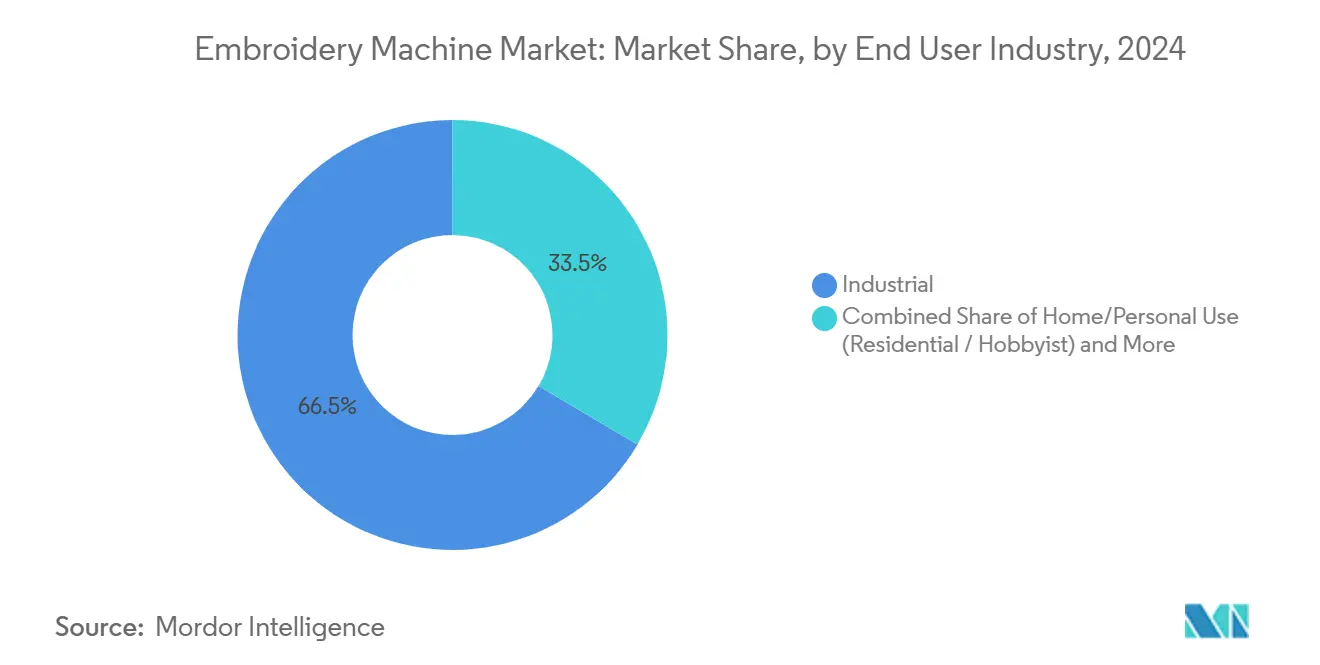
Note: Segment shares of all individual segments available upon report purchase
By Distribution Channel: Online Growth Challenges Dealer Networks
Offline dealers own 70.5% of revenue today, but direct OEM websites and marketplaces already contribute double-digit growth. The embroidery machine market size associated with online retail is projected to surpass USD 0.45 billion by 2030 as transparent pricing and integrated financing—such as Ricoma’s USD 200-per-month packages—gain acceptance.
Hybrid procurement patterns emerge; buyers research online, then complete the deal offline to secure service contracts, or vice-versa when urgent capacity needs dictate immediate shipment.
Geography Analysis
Asia-Pacific owns 63.5% of global revenue and leads with 7.8% CAGR, anchored by China’s digitised contract facilities and India’s enlarged PLI budget. The embroidery machine market size in Asia-Pacific is poised to climb from USD 0.76 billion in 2025 to USD 1.10 billion by 2030. Bangladesh and Thailand also upgrade fleets to capture diverted sourcing from higher-cost regions. Japan retains leadership in small-lot, high-mix production, relying on multi-function machines that balance agility with accuracy.
North America expands steadily on customisation demand and collegiate licensing. Near-shoring via the USMCA strengthens machine utilisation in Mexico, supporting mid-range multi-head installations with quick-turn embroidery fulfilment. Sustainability goals further drive the adoption of thread-based decoration among corporate apparel suppliers, replacing chemical prints.
Europe’s USD 178.5 billion textile sector navigates energy prices and an ageing workforce. Outsourcing to Eastern Europe supports machinery sales in Poland and Romania, while Western OEMs adopt automation to offset labour shortages. EU eco-design policy accelerates adoption of recyclable threads and componentised garments, lifting technical-spec investment despite sluggish apparel volume.
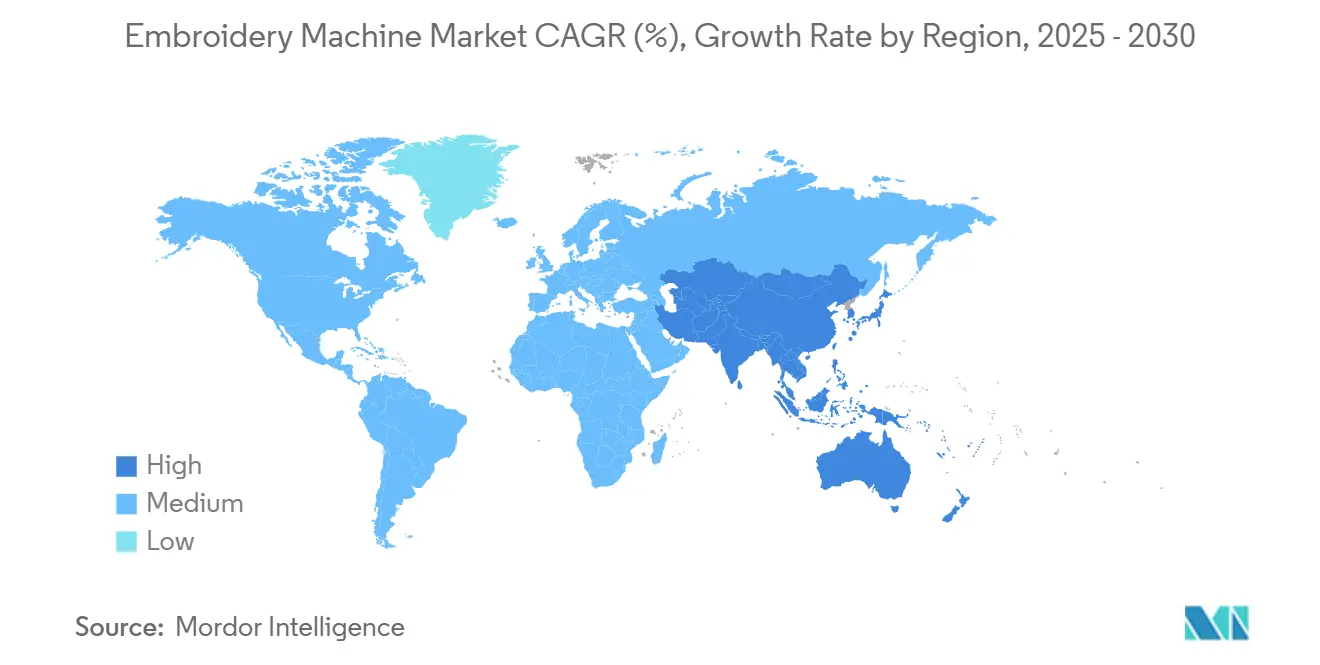
Note: Segments share of all individual segments available upon report purchase
Competitive Landscape
The Embroidery Machine Market remains moderately fragmented. Japanese incumbents Brother and Tajima maintain technological leadership via R&D outlays exceeding USD 300 million annually and features such as automatic thread-tension systems. German specialist ZSK commands niche, high-value segments in aerospace-grade tailored-fibre placement. Chinese challengers Zhejiang Lejia and BAI compete aggressively on cost, bundling LAN cards and touchscreen panels that mirror premium competitors at 20-30% lower price.
Brother’s “CS B2027” plan earmarks USD 1.33 billion for acquisitions that broaden industrial printing and labelling capabilities, indirectly boosting embroidery R&D. Tajima, meanwhile, focuses on software ecosystems and cloud-based pattern management to lock in recurring revenue. Service and training commitments emerge as key differentiators in regions plagued by skill shortages.
Grey-market control boards continue to erode OEM margins in Southeast Asia, prompting branded suppliers to implement QR-code traceability and extended warranties. AI-based predictive-maintenance add-ons, field-tested in Chinese plants, reduce unplanned downtime by 15%, offering a new lever for price premia. Overall, buyers weigh lifetime support and digital-integration roadmaps more heavily than purely mechanical specifications.
Embroidery Machine Industry Leaders
-
Brother Industries, Ltd
-
Bernina International AG
-
Janome Sewing Machine Co., Ltd.:
-
Tajima Industries Ltd.
-
Ricoma International Corporation
- *Disclaimer: Major Players sorted in no particular order
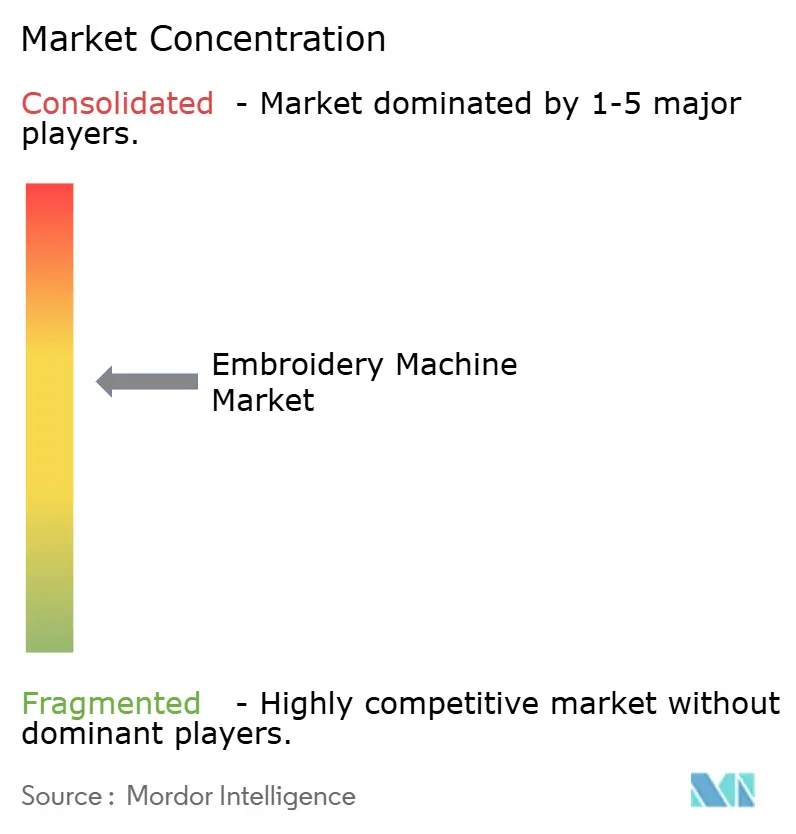
Recent Industry Developments
- March 2025: India raised PLI scheme outlay for textiles to Rs 1,148 crore (USD 1.38 billion) to spur technical-textile production.
- March 2025: Government cleared seven PM MITRA parks with cumulative funding of Rs 4,445 crore (USD 5.36 billion) to create 300,000 jobs.
- November 2024: Vietnam reiterated a USD 48 billion textile-export ambition for 2025, reinforcing investment in high-speed embroidery capacity.
- August 2024: India projected textile exports to reach USD 65 billion by FY-26, underlining upstream demand for embroidery machinery.
Global Embroidery Machine Market Report Scope
An embroidering machine is a machine used to create decorative designs or patterns on fabric using different types of stitches and colors of thread. Embroidery machines are often used to add intricate and individualized details to clothing, linens, and other fabrics.
The report provides a comprehensive background analysis of the embroidery machine market, covering current market trends, restraints, technological updates, and detailed information on various segments and the competitive landscape of the industry. Additionally, the COVID-19 impact has been incorporated and considered during the study.
The embroidery machine market is segmented by type (free motion embroidery machine, Cornely hand-guided embroidery machine, computerized embroidery machine (single-head embroidery machine, multi-head embroidery machine, Schiffli embroidery machine), end user (residential, commercial), distribution channel (online and offline), and geography (North America, Europe, Asia-Pacific, Middle East and Africa, and South America).
The report offers market size and forecasts for the embroidery machine market in value (USD) for all the above segments.
| Single-Head Embroidery Machines |
| Multi-Head Embroidery Machines |
| Chenille Embroidery Machines |
| Others (Sequin, Laser, Cap/Flat, etc.) |
| Manual Embroidery Machines |
| Semi-Automatic Machines |
| Fully Automatic/Computerized Machines |
| Apparel & Garments |
| Home Textiles |
| Technical Textiles (Auto, Medical, Aero) |
| Others (Fashion Accessories, Corporate Branding & Uniforms, Promotional Products, etc,) |
| Home/Personal Use (Residential / Hobbyist) |
| Commercial/Small Business Use (Less Than 10 machines) |
| Industrial Use (Greater Than 10 machines) |
| Others (Vocational Training, Fashion/ Design Schools) |
| Offline (Direct, Dealers, Specialty, Big-Box) |
| Online (OEM Direct, E-commerce) |
| North America | United States |
| Canada | |
| Mexico | |
| South America | Brazil |
| Argentina | |
| Peru | |
| Rest of South America | |
| Europe | United Kingdom |
| Germany | |
| France | |
| Italy | |
| Spain | |
| BENELUX (Belgium, Netherlands, and Luxembourg) | |
| NORDICS (Denmark, Finland, Iceland, Norway, and Sweden) | |
| Rest of Europe | |
| Asia-Pacific | China |
| India | |
| Japan | |
| Australia | |
| South Korea | |
| ASEAN (Indonesia, Thailand, Philippines, Malaysia, Vietnam) | |
| Rest of Asia-Pacific | |
| Middle East and Africa | Saudi Arabia |
| United Arab Emirates | |
| Qatar | |
| Kuwait | |
| Turkey | |
| Egypt | |
| South Africa | |
| Nigeria | |
| Rest of Middle East and Africa |
| By Product | Single-Head Embroidery Machines | |
| Multi-Head Embroidery Machines | ||
| Chenille Embroidery Machines | ||
| Others (Sequin, Laser, Cap/Flat, etc.) | ||
| By Technology | Manual Embroidery Machines | |
| Semi-Automatic Machines | ||
| Fully Automatic/Computerized Machines | ||
| By Application | Apparel & Garments | |
| Home Textiles | ||
| Technical Textiles (Auto, Medical, Aero) | ||
| Others (Fashion Accessories, Corporate Branding & Uniforms, Promotional Products, etc,) | ||
| By End-User | Home/Personal Use (Residential / Hobbyist) | |
| Commercial/Small Business Use (Less Than 10 machines) | ||
| Industrial Use (Greater Than 10 machines) | ||
| Others (Vocational Training, Fashion/ Design Schools) | ||
| By Distribution Channel | Offline (Direct, Dealers, Specialty, Big-Box) | |
| Online (OEM Direct, E-commerce) | ||
| By Geography | North America | United States |
| Canada | ||
| Mexico | ||
| South America | Brazil | |
| Argentina | ||
| Peru | ||
| Rest of South America | ||
| Europe | United Kingdom | |
| Germany | ||
| France | ||
| Italy | ||
| Spain | ||
| BENELUX (Belgium, Netherlands, and Luxembourg) | ||
| NORDICS (Denmark, Finland, Iceland, Norway, and Sweden) | ||
| Rest of Europe | ||
| Asia-Pacific | China | |
| India | ||
| Japan | ||
| Australia | ||
| South Korea | ||
| ASEAN (Indonesia, Thailand, Philippines, Malaysia, Vietnam) | ||
| Rest of Asia-Pacific | ||
| Middle East and Africa | Saudi Arabia | |
| United Arab Emirates | ||
| Qatar | ||
| Kuwait | ||
| Turkey | ||
| Egypt | ||
| South Africa | ||
| Nigeria | ||
| Rest of Middle East and Africa | ||
Key Questions Answered in the Report
What is the current value of the embroidery machine market in 2025?
The market is valued at USD 1.20 billion in 2025 and is projected to grow at a 5.92% CAGR to 2030.
Which region leads the embroidery machine market?
Asia-Pacific accounts for 63.5% of global revenue in 2024 and posts the fastest regional growth at 7.8% CAGR through 2030.
How are government incentives influencing demand?
India’s expanded PLI allocation and planned PM MITRA parks incentivise technical-textile capacity, directly boosting orders for advanced embroidery lines.
Which is the fastest growing region in Embroidery Machine Market?
Multi-head machines dominate with 68.7% revenue share in 2024, though single-head units are growing faster at 8.7% CAGR.
Which region has the biggest share in Embroidery Machine Market?
In 2025, the North America accounts for the largest market share in Embroidery Machine Market.
What technology trend is shortening machine pay-back periods?
IIoT-enabled Overall Equipment Efficiency analytics in contract factories improve utilisation and cut pay-back cycles to under two years.
Why is technical textiles the fastest-growing application?
Automotive lightweighting, medical implants and aerospace composite components rely on precise, functional stitching, propelling technical-textile equipment at a 10.0% CAGR.
Page last updated on:
